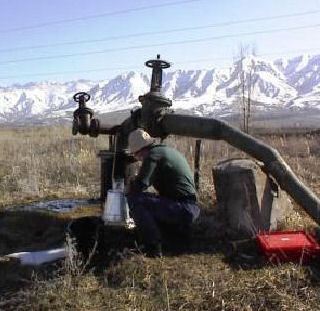Environmental tracers and groundwater dating

The BGS is the UK's leading organisation for groundwater dating and tracing. We use a wide range of environmental agents for this work including CFCs, SF6, tritium, radiocarbon and stable isotopes.
Some of our recent work includes:
- characterising the isotopic fingerprint of phosphorus in drinking water
- investigating residence time distribution in Chalk catchments
- using age indicators to aid water supply operational planning
- assessing the extent of induced leakage to urban aquifers
- identifying basin-scale groundwater quality trends
- determining the fate of nitrogen in moorland catchments
- evaluating the effects of large-scale quarrying on groundwater movement
- delineating the occurrence of pristine ice-age groundwaters in the UK
Why is the age of groundwater important?
There are various reasons why it can be important to know the age of groundwater in a particular aquifer. For example: does age validate the hydrogeological concept? Is the water a mixture of different ages? Is the water sustainable or being 'mined'? Did the water recharge in pre-industrial times? Was the water recharged during the ice age, i.e. under different climatic conditions?
Which constituents can be used to date groundwater?
Some groundwater dating agents, for example radiocarbon (14C) are produced naturally in the environment and are suitable for dating waters many thousands of years old. Others, such as the chlorofluorocarbons (CFCs), are the result of man-made inputs to the environment and are best suited to dating young groundwaters. In some cases such anthropogenic compounds can also be used to trace groundwater flowpaths.
Contact
Contact Enquiries (hydroenq@bgs.ac.uk) for further information.
- BGS groundwater dating publications
- Using environmental tracers to assess the extent of river-groundwater interaction in a quarried area of the English Chalk
- Groundwater residence time and movement in the Maltese islands: a geochemical approach
- Anomalous alkaline sulphate fluids produced in a magmatic hydrothermal system: Savo, Solomon Islands
- Groundwater nitrogen composition and transformation within a moorland catchment, mid-Wales
- Enquiries (hydroenq@bgs.ac.uk)






